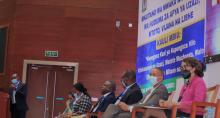WHO advocates for quality of care for women and children
17-19 November 2021, Dar es Salaam – Much progress has been made during the past two decades in coverage of births in health facilities; however, reductions in maternal and neonatal mortality remain slow. With increasing numbers of births in health facilities, attention has shifted to the quality of care, as poor quality of care contributes to morbidity and mortality. The period around childbirth is the most critical for saving the maximum number of maternal and newborn lives and preventing stillbirths.
The World Health Organization identifies quality of care for women and children as a priority in addressing preventable maternal and child mortality and sees a future in which “Every pregnant woman and newborn receives high-quality care throughout pregnancy, childbirth and the postnatal period”. It is in this context that WHO participated in the Annual Reproductive, Maternal, Newborn, Child and Adolescent Health (RMNCAH) Scientific Conference.
Organized by the Ministry of Health, Community Development, Gender, Elderly and Children together with the Jakaya Mrisho Foundation, the meeting brought together health care workers from all levels, health managers, academicians and researcher policy makers, elected officials non-state actors and high-ranking government officials.
The conference officiated by the Prime Minister Kassim Majaliwa and hosted by the former President Jakaya Kikwete, launched the new agenda for family planning 2030 with the aim of reducing maternal and neonatal deaths.
“The Family Planning agenda 2030 is amongst the government plans that aims to create the best and strongest health services, to protect a mother and a child by investing in family planning as it is very important in the development of the economy,” said the Prime Minister. He also added that there is a need for a curriculum review which aims at identifying the right education to be given, depending on the age groups of the students. The review has to also consider the right balanced diet among the youth as a way of strengthening the reproductive health agenda.
Tanzania is among the five countries in the world where the maternal mortality rate averaged 10,000 women in 2017 (WHO, 2019). More than 40% of all infant deaths occur during childbirth (Labor). Some of the positive indicators include an increase in the number of pregnant women giving birth at delivery centers to 80 percent and, 90 percent of pregnant women making four or more prenatal clinic visits and increased immunization of Children. However, compared with a goal of reducing maternal deaths to 70 per each 100,000 births, from the current level of 432 deaths progress is slow.
Speaking at the conference, the WHO Country Representative, Dr. Tigest Ketsela Mengestu, emphasized that it was critical to improve quality of services for mothers, newborns, and children. “With the increased access to health facilities at 90 percent more investment is now crucial in quality of care provided. This is key to preventing deaths of women and newborns during childbirth. Without investment in human resources, medicines, specialized care, maternal and newborn deaths will only shift from community to health facilities” she remarked.
Currently, Tanzania health systems manages with 53 percent gap in human resource and 86 percent of the population must foot medical bills from out of pocket since only 14 percent of all Tanzanians have medical insurance.
Through myriad of panel and plenary discussion covering scientific and policy areas related to RMNCAH conference the participants of the conference put their heads on innovative ways to increase investment in quality of services.




